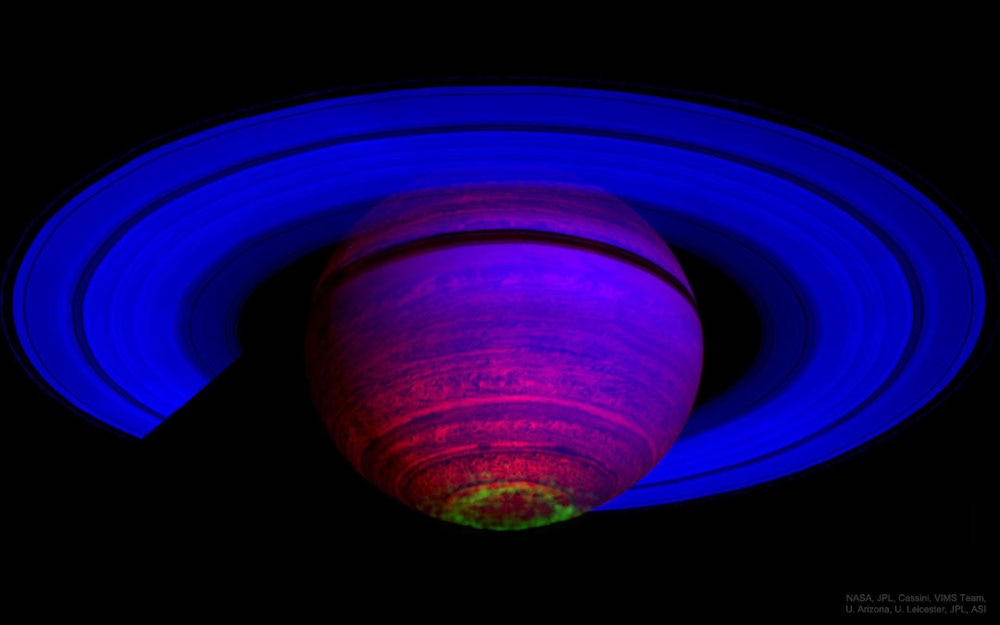Create a free profile to get unlimited access to exclusive videos, sweepstakes, and more!
Spectacular light shows are in the weather forecast on Saturn
It's going to be cloudy with a chance of aurora borealis.

If an aurora on Earth seems unearthly, you haven’t seen one on Saturn.
Saturn’s auroras are surreal even for an alien planet. They were also connected to something of an enigma until now. After NASA’s Cassini orbiter found that a day on Saturn (which is barely 11 hours) seemed to have mysteriously grown longer in the decades since the Voyagers glimpsed it, whatever was causing this significant change remained unknown. Planets don’t just change their rotation periods like that. The thing is, auroras are also periodic phenomena.
Far above other planets, such as Earth and Jupiter, charged particles interact with the magnetic field to form the spectacles known as auroras. Researcher Nahid Chowdhury of the University of Leicester led a study, recently published in Geophysical Research Letters, revealing how most of them form. Turns out most Saturnian auroras aren’t caused by particles interacting with its outer magnetic fields. They just need swirling winds in the atmosphere to make them light up.
“The auroras of Saturn were thought to be formed by charged particles coming from water geysers on the surface of its icy moon Enceladus,” Chowdhury told SYFY WIRE. “No one was able to tell whether processes in the planet's upper atmosphere could influence the auroral emissions produced at Saturn.”
What gave away the actual source of the auroras were measurements of their infrared emissions compared to flows of the hydrogen ion H3+ in the gas giant’s ionosphere, the part of the atmosphere swarming with ions, which are atoms that gain or lose electrons, and random electrons. Observing Saturn’s auroral regions in the infrared from Keck Observatory in Hawaii showed Chowdhury and his team the spectra of light coming from those regions. Light spectra can give away what substances are floating around, and the researchers were able to make out the signature of H3+, which told them more about the behavior of the ionosphere.
This is a first for a ground-based telescope such as Keck. Such observations of Saturn had never been made, but it was possible because there had been similar views of Jupiter. The spectra detected from the ion flows were separated into groups depending on whether they were seen at midnight, dawn, noon, and dusk on Saturn. They were then compared to each other and mapped into what looks like a glowing planetary rainbow in the image above.
“The ion flows in Saturn’s ionosphere, driven by weather cells, are important for generating auroras,” said Chowdhury. “They are the ultimate driving mechanism for the variabilities and periodicities observed within parameters throughout the Saturnian environment."
Just like on Earth, weather cells on Saturn are regions where air whirls from low-pressure to high-pressure zones over and over. The weather cells in Saturn’s atmosphere arise from processes deeper in the planet. It is possible that the weather system which generates these auroras is pushed by the thermosphere, which is the second highest atmospheric level, known for extreme heat. More observations need to be made to see whether this is actually what is going on. Chowdhury thinks that could be problematic without something to replace Cassini.
“Ideally, we want measurements of how material is flowing lower down in the planet's atmosphere in order to provide more answers,” he said.
Something needs to plunge deeper in the atmosphere and take a look up close to beam back evidence of the forces driving ion flows, which eventually spark Saturn’s auroras. Another mission like Cassini may not take off for a while. At least it is possible that observations of similar phenomena on other planets like Jupiter may shed more light on these lightscapades.
While auroras might not be the main attraction for Earthlings, Saturn is obviously so much more than its rings.


























